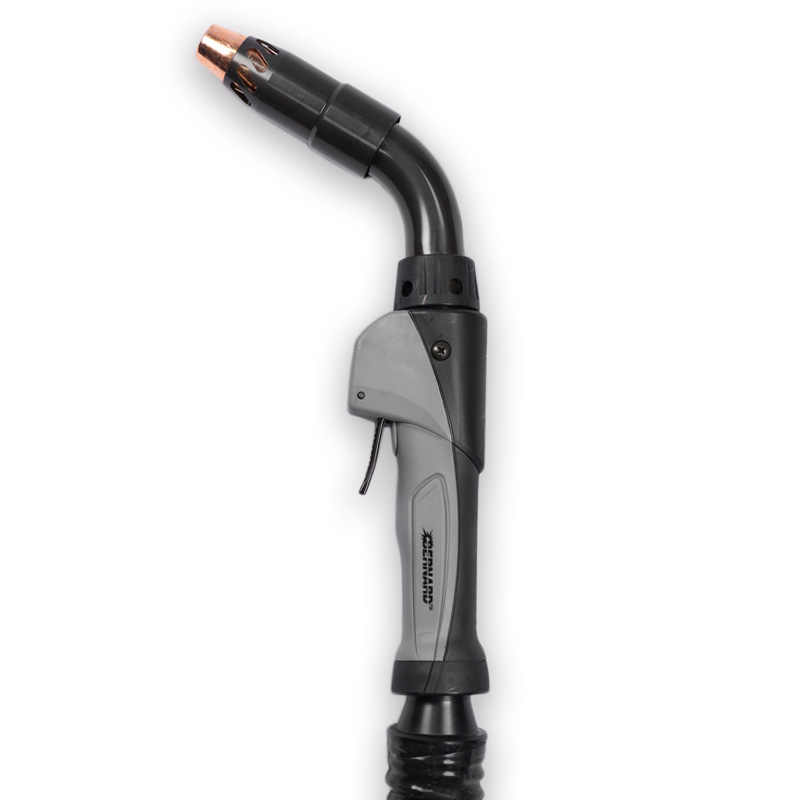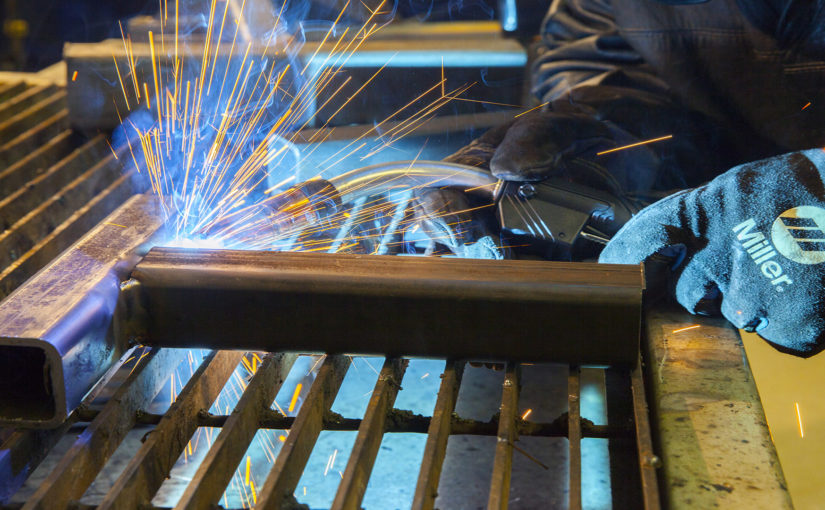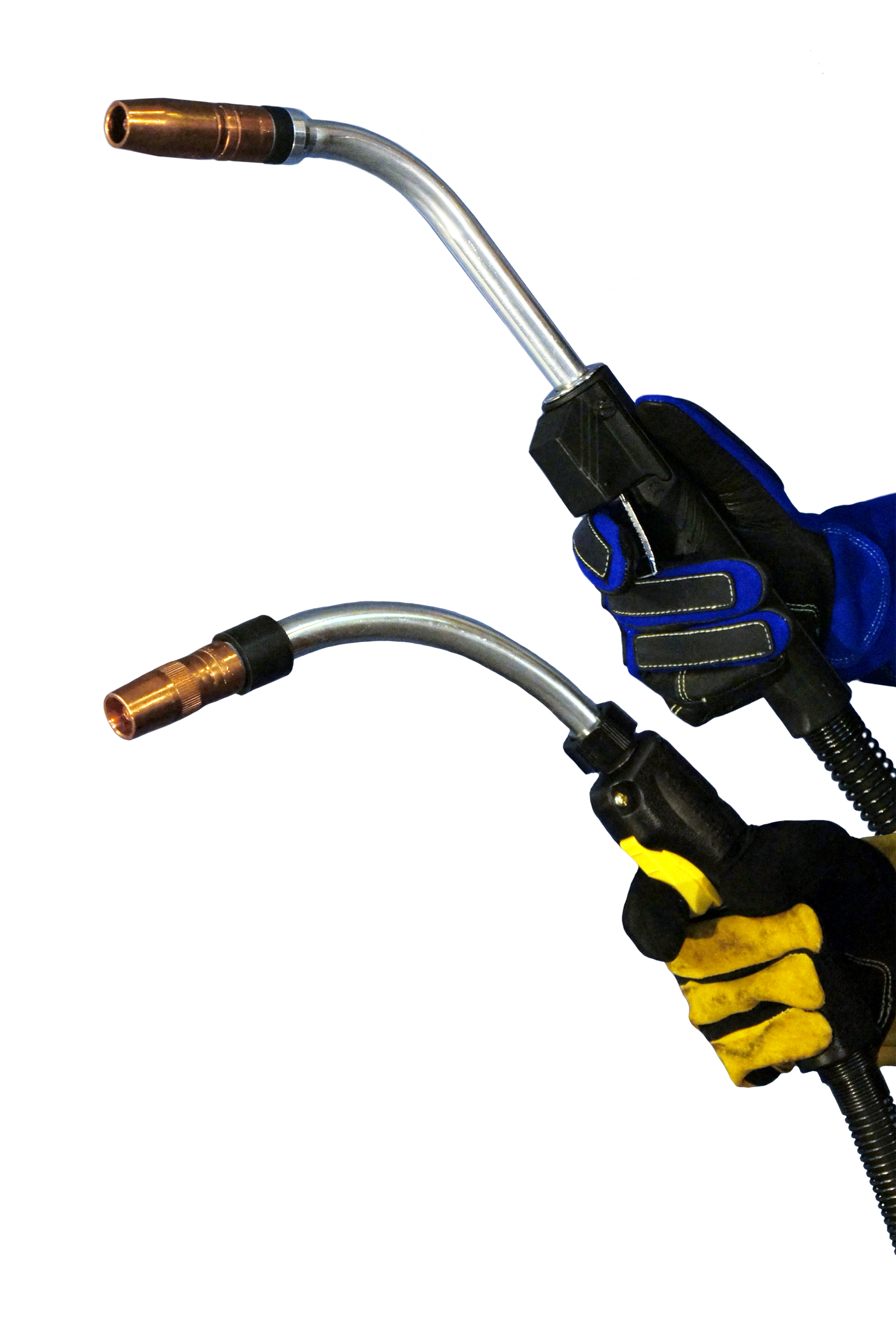MIG welding is among the easiest welding processes to learn and is useful for a variety of applications. Since the welding wire constantly feeds through the MIG gun, it doesn’t require frequent stopping, as with stick welding. The result is faster travel speeds and greater productivity. Its versatility and speed make MIG welding a good option for all-position welding on various metals in a range of thicknesses. In addition, it produces cleaner welds that require less cleanup than stick or flux-cored welding.
To maximize the benefits this process offers, however, it’s important to select the right MIG gun for the job. Depending on its specifications, a MIG gun can significantly impact productivity, downtime, weld quality and operating costs—as well as welding operators’ comfort. From amperage to maneuverability, keep reading to learn about key factors to consider when selecting a MIG gun.
What’s the right MIG gun amperage?
Always select a MIG gun that offers the amperage and duty cycle needed to prevent overheating. Duty cycle refers to the number of minutes in a 10-minute period that a gun can be operated at its full capacity without overheating. A 60 percent duty cycle, for example, means six minutes of arc-on time in a 10-minute span. But most welding operators don’t weld 100 percent of the time. So you can typically use a lower-amperage gun than your procedure calls for—getting the job done with a gun that is lighter and easier to maneuver.
When you evaluate a gun’s amperage, always consider the shielding gas you plan to use—because it could make a big difference. Manufacturers test most guns for duty cycle based on their performance with 100 percent CO2 because it tends to keep the gun cool. But a mixed-gas combination—like 75 percent argon and 25 percent CO2, for example—makes the arc hotter. This reduces the duty cycle, causing the gun to operate hotter and become less durable.
Water- versus air-cooled
When deciding between a water- or air-cooled MIG gun, there are a few factors you should consider. Specifically, you should focus on the application and amperage requirements, welding operator’s preference and cost considerations.
Water-cooled MIG welding systems pump cooling solution from a radiator unit, usually integrated inside or near the power source. The coolant passes through hoses inside the cable bundle and into the gun handle and neck. It then returns to the radiator, where a baffling system releases the heat absorbed by the coolant. The ambient air and shielding gas further disperse the heat from the welding arc.
If you’re welding sheet metal for only a few minutes every hour, you don’t need a water-cooled system. On the other hand, shops with stationary equipment that repeatedly weld at 600 amps will likely need a water-cooled MIG gun to handle the heat the applications generate.
Conversely, an air-cooled system relies solely on the ambient air and shielding gas to dissipate the heat that builds up along the length of the welding circuit. These systems, which range from 150 to 600 amps, use much thicker copper cabling than water-cooled systems. By comparison, water-cooled guns range from 300 to 600 amps.
Each system has its advantages and disadvantages. Water-cooled guns are more expensive upfront and can require more maintenance and operational costs. However, water-cooled guns can be lighter and more flexible than air-cooled guns, which provides productivity advantages by reducing operator fatigue. But because water-cooled guns require more equipment, they can also be impractical for applications that require portability.
Heavy- versus light-duty
Light-duty MIG guns are usually ideal for applications that require short arc-on times, like tacking parts or welding sheet metal. They typically provide 100 to 300 amps of capacity, and they tend to be lighter and smaller than heavier-duty guns. Most light-duty MIG guns have small, compact handles as well, making them more comfortable for the welding operator. Light-duty MIG guns offer standard features at a lower price. They use light- or standard-duty consumables (nozzles, contact tips and retaining heads), which are less expensive than their heavy-duty counterparts.
The strain relief on light-duty guns is usually composed of a flexible rubber component and can sometimes be absent. With that in mind, take care to prevent kinking that may impair wire feeding and gas flow. Also note that overworking a light-duty MIG gun can lead to premature failure. If your facility has multiple applications with multiple amperage needs, this type of gun may not be appropriate.
At the other end of the spectrum, heavy-duty MIG guns are the best choice for more demanding welding jobs. Consider a heavy-duty MIG gun for any application that requires long arc-on times or multiple passes on thick sections of material. These guns generally range from 400 to 600 amps and are available in air- and water-cooled models. They often have larger handles to accommodate the larger cables that are required to deliver these higher amperages. The guns frequently use heavy-duty front-end consumables that are capable of withstanding high amperages and longer arc-on times. The necks are often longer as well, to put more distance between the welding operator and the high heat output from the arc.
Fume extraction guns
 For some applications and welding operations, a fume extraction gun may be the best option. Fume extraction guns remove the fumes at the source, minimizing the amount that enters the welding operator’s immediate breathing zone. This makes them a great option for companies looking to optimize worker safety, attract new talent and comply with tight regulations. Industry standards from the Occupational Safety and Health Administration (OSHA) and other safety regulatory bodies that dictate allowable exposure limits of welding fumes and other particulates (including hexavalent chromium) have led many companies to make the investment.
For some applications and welding operations, a fume extraction gun may be the best option. Fume extraction guns remove the fumes at the source, minimizing the amount that enters the welding operator’s immediate breathing zone. This makes them a great option for companies looking to optimize worker safety, attract new talent and comply with tight regulations. Industry standards from the Occupational Safety and Health Administration (OSHA) and other safety regulatory bodies that dictate allowable exposure limits of welding fumes and other particulates (including hexavalent chromium) have led many companies to make the investment.
While fume extraction guns can certainly help companies maintain compliance, there are a lot of other factors to consider, including:
-
- Welding wire selection
- Specific transfer methods and welding processes
- Welding operator behavior
- Base material selection
These guns operate by capturing the fumes generated by the welding process right at the source, over and around the weld pool. Various manufacturers have proprietary means of constructing guns to conduct this action. At a basic level, however, they all operate similarly: by mass flow or the movement of material. This movement occurs by way of a vacuum chamber that suctions the fumes through the handle of the gun and into the gun’s hose through to a port on the filtration system (a.k.a vacuum box).
Fume extraction guns are well-suited for confined space applications, or applications that use solid, flux-cored or metal-cored welding wire. These applications are common among shipbuilding and heavy equipment manufacturing industries, as well as general manufacturing and fabrication. They are also ideal for welding mild and carbon steel—and stainless steel, because it generates greater levels of hexavalent chromium. In addition, the guns work well on high amperage and high deposition rate applications.
Other considerations: Cables and handles
Manufacturers offer industrial cables up to 25 feet long, but shorter is typically better. The longer the cable, the more chance it can get coiled around things in the weld cell or looped on the floor and possibly disrupt wire feeding. Choose the smallest, shortest and lightest cable capable of handling the amperage you need. This can offer greater flexibility, making it easier to maneuver the MIG gun and minimize clutter in the workspace.
However, there are definitely situations that warrant a longer cable. If you’re welding a large part or have to move around corners, choose a longer cable to facilitate more movement. Or if you plan to move back and forth between long and short distances, a steel mono coil cable might be the better choice. This type of cable doesn’t kink as easily as standard industrial cables and can provide smoother wire feeding.
A MIG gun’s handle and neck design can impact how long an operator can weld without experiencing fatigue. Handle options include straight or curved, both of which come in vented styles. The choice often boils down to welding operator preference.
A straight handle is the best choice for operators who prefer a trigger on top, since curved handles, for the most part, do not offer this option. With a straight handle, the operator can rotate the neck to place the trigger on top or on bottom.
Conclusion
In the end, minimizing fatigue, reducing repetitive motion and decreasing physical stress contributes to a safer and more productive environment. Choosing a MIG gun that offers the best comfort and operates at the coolest temperature allowed by the application can help improve arc-on time and productivity—and, ultimately, increase the profitability of the welding operation.

